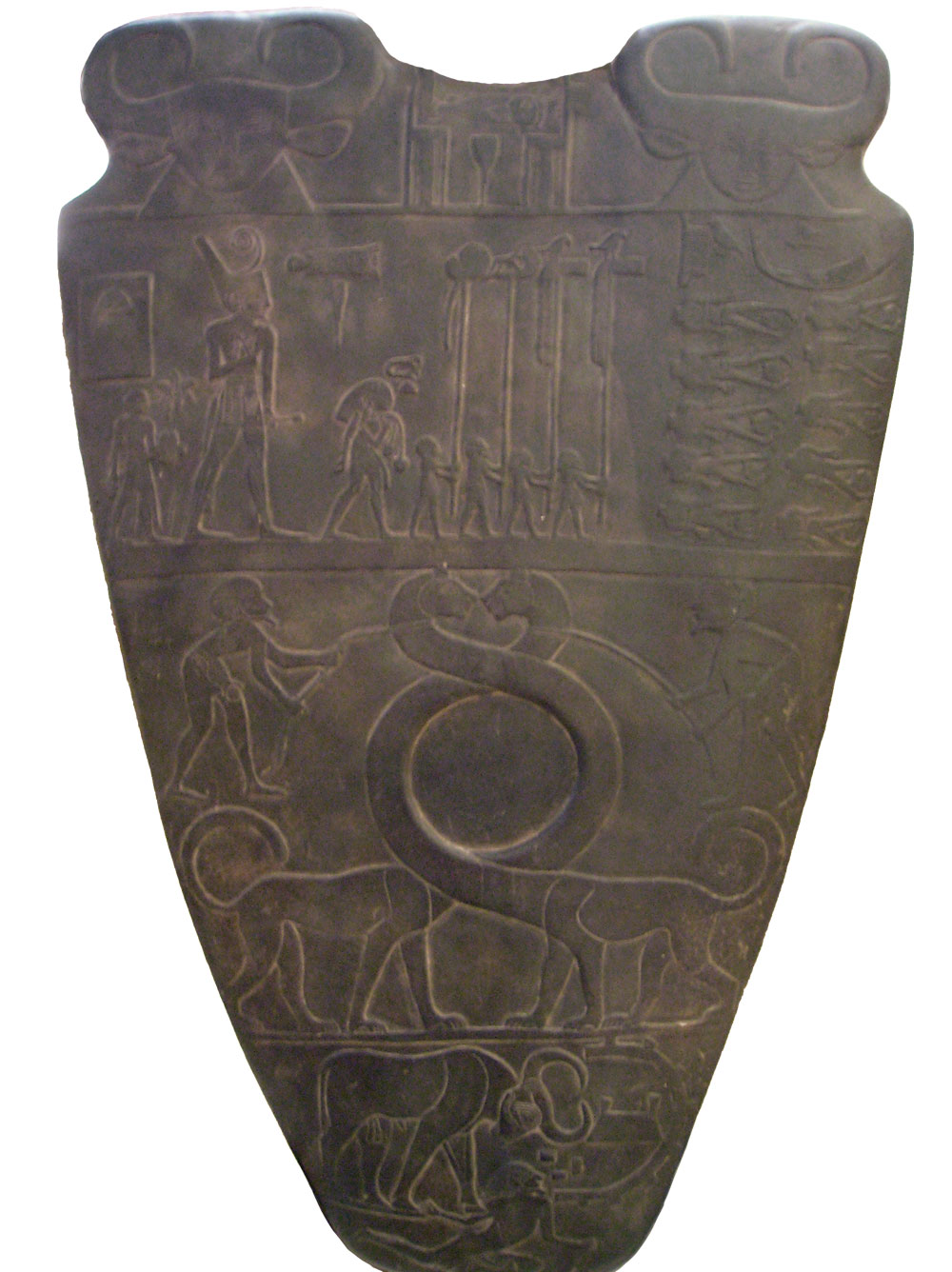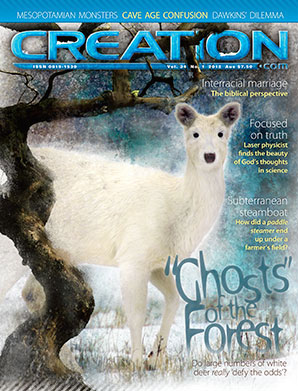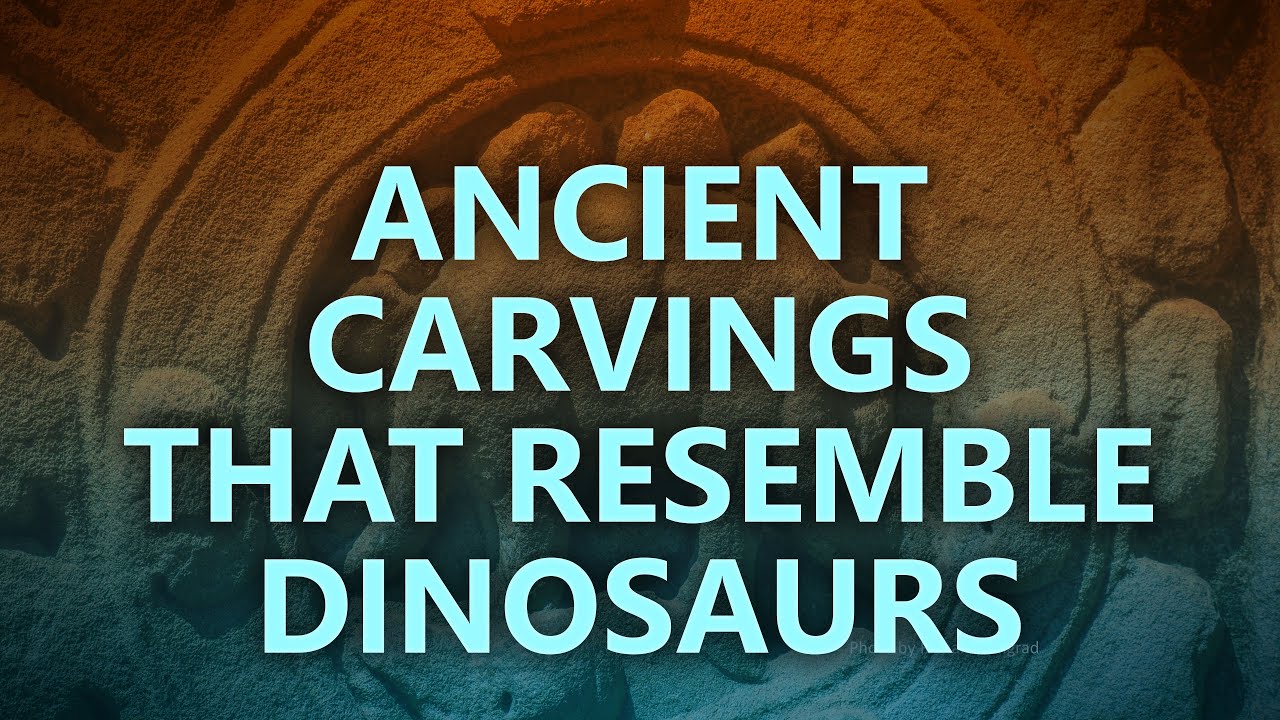Mesopotamian monsters in Paris

Among the many ancient artefacts displayed in our museums are small barrel-shaped objects, having a small hole through their centre and engraved on their peripheries with various images. When rolled onto wet, malleable clay, they leave an impression, in a similar way to how a roller stamp leaves an ink print on paper. They are often referred to as ‘cylinder seals’ (as opposed to ‘stamp seals’) and were used to authenticate documents, indicate ownership, or decorate artefacts. A particularly interesting example exists in the Louvre museum in Paris1 (see fig. 1 and 2). It is made of jasper and was found at Uruk in Mesopotamia (Iraq).
Uruk comprises the remains of what was once a magnificent complex of buildings, on a par with some of the best European architecture seen today. Many examples of artwork have been discovered there, including artefacts bearing impressions from cylinder seals. These often depict domesticated or wild animals, symbolizing the powers promoting or threatening human life. Some feature ‘composite creatures’, such as those in the example in fig. 1 and 2, which the archaeologist Professor Anton Moortgat described as a ‘snake-dragon’ (the main creature with the long neck) and a ‘lion-headed eagle’ (seen flying between the tails of the ‘snake-dragons’).2
According to the secular account of Earth history, dinosaurs lived and died millions of years before people even existed. Acceptance of this view, of course, seriously compromises the Bible, as this teaches that the world is not millions of years old and that God made the land dwelling creatures (which would have included the dinosaurs), along with Adam and Eve, on the sixth day of creation (Genesis 1:24–28). Moreover, since the Bible teaches that every kind of air-breathing land animal and bird was represented on Noah’s Ark, the world would have been repopulated with both people and dinosaurs after the Flood (Genesis 7:3 and 8:17). As such, we would expect to find evidence of dinosaurs living alongside man in recent history—and, indeed, this is what we find in abundance.


‘Dragons’ is a universal theme, right across the globe, prominent in many different cultures, over a vast span of human history. Accounts of dragons come from China, Australia, Africa, Europe, North America and South America. It’s everybody’s legend! Interestingly, the descriptions of these dragons are remarkably similar, from country to country and from tribe to tribe—large reptiles with scales; some fly, some do not; if they fly, they have wings like a bat; some breathe fire; they have sharp teeth and claws—often three claws like the theropod dinosaurs.3,4


Ancient writers, such as the Greek historian Herodotus,5 Apollonius of Tyana6 and Marco Polo7 provided detailed descriptions of creatures which closely resemble the dinosaurs reconstructed in our museums. According to Mesopotamian legend, the ancient Uruk king Gilgamesh, along with his friend Enkidu, killed a fearsome creature called Khumbaba (or Humbaba).8,9 This monster, which lived in a cedar forest, was said to have the shape of a dragon, a voice like a storm and to spit fire.10 It was also described as having a long tail and talons on its feet.11 Many ancient artefacts exist which depict other dinosaur-like creatures, such as the Nile mosaic of Palestrina,12 a mural in the House of the Physician in Pompeii,13 a stone carving at Angkor in Cambodia14 and the brass engravings around the tomb of Bishop Bell in Carlisle Cathedral (see fig. 3).15
Although somewhat stylized, the ‘snake-dragon’ engraved on the cylinder seal in fig. 1 is another example. The long neck and long tail are characteristic of many of the reptilian ‘monsters’ found in the fossil record, such as Tanystropheus and Brachiosaurus (fig. 4). The creatures are shown ‘necking’, as do animals seen today, such as giraffes. Interestingly, dinosaur-like creatures are seen engaging in this type of behaviour in other ancient artwork, such as in the Narmer Palette (fig. 5), the engravings on Bishop Bell’s tomb (fig. 3) and the Roman mosaic shown in fig. 6. The first century naturalist Pliny the Elder recorded that the dragons of Ethiopia were often seen ‘twisted and interlaced together’.16 Although strange at first sight, the claws on the feet of the ‘snake-dragon’ in fig. 1 very likely depict a stylized form of reality, as tracks of sauropod dinosaurs are known to include claw impressions.17 The feet of Saltasaurus and Camarasaurus are depicted with spiked protrusions, for example.18,19 The bulging muscles are also typical of modern dinosaur reconstructions.

It is difficult to see how artists from ancient times could have produced such good representations of the great reptiles of history unless they had either seen them themselves or had accurate accounts passed down to them from eye witnesses. It took modern palaeontologists many decades to begin to faithfully reconstruct these magnificent animals. These historical depictions of ‘dragons’ and ‘monsters’ confirm the Bible’s testimony that dinosaurs and people lived side by side in recent times, and confute the evolutionary claim that dinosaurs died out 65 million years ago.22
Re-posted on homepage: 30 May 2024
References
- Department of Oriental Antiquities, Richelieu wing, ground floor, room 1a. https://commons.wikimedia.org/wiki/File:Cylinder_seal_lions_Louvre_MNB1167.jpg. Return to text.
- Moortgat, A., The art of ancient Mesopotamia, Phaidon Press, London, 1969, pp. 1, 9, 10 and Plate A. Return to text.
- Dragons or Dinosaurs, documentary DVD by Cloud Ten Pictures, New York, 2010. Return to text.
- Isaacs, D., Dragons or Dinosaurs?, Bridge-Logos Foundation, USA, 2010. Return to text.
- Herodotus, The histories, Penguin, 2003, pp. 124-125. Return to text.
- Philostratus, Life of Apollonius of Tyana, tr. by F.C. Conybeare, Heinemann, 1912, pp. 242-247. Return to text.
- Polo, M., The travels, Penguin, 1958, pp 178–180. Return to text.
- Coulter, C.R., and Turner, P., Encyclopedia of ancient deities, Fitzroy Dearborn, Chicago, 2000, p. 191. Return to text.
- This is recorded in the Epic of Gilgamesh, a poem inscribed on 12 clay tablets. It is one of the earliest known works of literature. The Epic of Gilgamesh also provides one of the many accounts of a great flood, paralleling that in Genesis, including the building of an Ark in which people and animals were saved from drowning, www.britishmuseum.org. See also, Conolly, R., and Grigg, R., Flood!, Creation 23(1):26-30, December 2000; Sarfati, J., Noah’s Flood and the Gilgamesh Epic, Creation 28(4):12–17, September 2006, creation.com/gilgamesh. Return to text.
- Ref. 8, p. 270. Return to text.
- Rose, C., Giants monsters and dragons. An encyclopedia of folklore, legend and myth, ABC-CLIO, USA, 2000, p.p. 180, 181. Return to text.
- This features a creature labelled ‘KROKODILOPARDALIS’ or ‘crocodile leopard’. See https://en.wikipedia.org/wiki/Nile_mosaic_of_Palestrina. Return to text.
- Kraus, T., Pompeii and Herculaneum, Harry Abrams, New York, 1975, p. 210, fig. 306. Return to text.
- Catchpoole, D., Angkor saw a stegosaur, Creation 29(4):56, September 2007. Return to text.
- Bell, P., Bishop Bell’s brass behemoths, Creation 25(4):40–44, September 2003. Return to text.
- Pliny the Elder, The natural history, translated by Bostock, J., vol. II, Book VIII, Chapter 13; www.perseus.tufts.edu. Return to text.
- Day, J.J. et al., Sauropod trackways, evolution and behaviour, Science 296(5573):1659, 31 May 2002. Return to text.
- See dsc.discovery.com/videos/dinosaur-planet-saltasaurus-lays-its-eggs.html. Return to text.
- https://videos.howstuffworks.com/discovery/27799-when-dinosaurs-roamed-america-the-camarasaurus-video.htm. Return to text.
- Wheeler, R.E.M. and Wheeler, T.V., Reports of the Research Committee of the Society of Antiquaries of London, No. IX, The Society of Antiquaries, London, 1932, pp. 65, 66 and Plate XIX A. Return to text.
- The Latin inscription probably reads, “To the god Nodens, Titus Flavius Senilis, officer in charge of the supply-depot of the fleet, laid this pavement out of money offerings; the work being in charge of Victorinus, interpreter on the Governor’s staff”. Ref. 20, p. 103. Return to text.
- See also Job 40:15–24 and Job 41:1–34. Return to text.








Readers’ comments
Comments are automatically closed 14 days after publication.